Graffiti
![]()
The title of this article is ambiguous. For other meanings, see Graffiti (disambiguation).
![]()
Writing is a redirect to this article. For the song by Elton John, see Writing (Elton John song).
Graffiti (Italian; singular graffito) is a collective term for thematically and creatively different visible elements, for example images, lettering or signs, which were created with various techniques on surfaces or by altering them in private and public space. The graffiti are mostly made under a pseudonym and illegally.
Creators of graffiti, especially when they use spray cans, are often called sprayers.
The acceptance and definition of graffiti varies. If unauthorized graffiti is mostly seen as a form of vandalism in the public perception, especially in the Western world, it is also recognized as a form of art from another side. However, the two are not mutually exclusive.
Public institutions take multi-layered measures to prevent the illegal application of graffiti. Many municipalities release special areas. The legal punishment extends to a ban on the possession of the corresponding tools. The Central Association of German House and Property Owners reported in 2005 that the removal of unauthorised graffiti from buildings and public transport costs around 500 million euros per year. Deutsche Bahn put its damages in 2012 at 33 million euros, and of 30,000 acts of vandalism, 14,000 were graffiti cases.
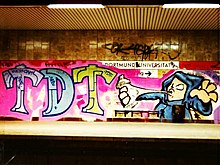
S-Bahn stop at the UniDo (1992)
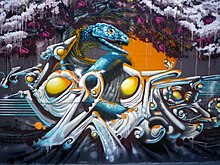
Graffito at the Hall of Fame in Ingolstadt
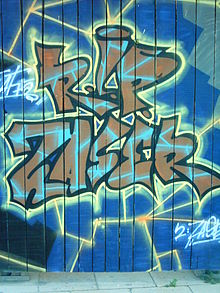
Graffito on a construction fence
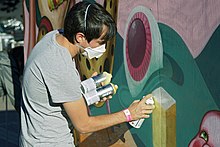
Sprayer at work (2012)
Word Origin
Graffiti is the plural of the Italian word graffito. It is etymologically derived from the Greek γράφειν (graphein), which means to write and draw.
In Italian, graffito originally meant hatching and referred (in addition to its modern meaning today) to an inscription or ornamental or figural decoration carved into stone (see also the stucco techniques of sgraffito).
Today it is also spoken of a graffiti instead of a graffito and the analogously formed plural graffitis is used. The Duden allows both terms.
In the official language of the GDR, graffiti as part of hip-hop youth culture was called "rap writing", derived from rap.
Forms of graffiti
There are many different types of graffiti, whose demarcation is often not clearly possible. For example, Klograffiti can also have political content or a writer paints a lettering with the name of his favorite football club. Especially the distinction between writing and street art is difficult, because the techniques often overlap.
Style Writing
Style writing/graffiti writing or writing for short is the most widespread form of graffiti by now and is therefore also perceived the most by the general public. Due to this fact, there is usually no differentiation from other forms of non-writing related graffiti in the general population. In writing, the writing (letters and numbers) forms the basic element of the image composition and the actors (writers) make an artistic claim on themselves. The most frequent dissemination of the name or rather the pseudonym of a graffiti writer in combination with its most unique, innovative and above all aesthetic design are the central goals in order to achieve maximum fame. The aesthetics, however, are the main focus. A Writer who paints a lot but does not have a good style is less likely to receive recognition from other scene members. Well-known writing artists include Loomit, DAIM or the Swiss Dare or the German-French Darco.
In hip-hop culture, writing is one of the four essential elements (along with MCing, DJing and B-Boying). The idea of non-violent competition and the resolution of conflicts on an artistic level (battle) is an essential characteristic of the peaceful writing culture - just as with the other elements of hip-hop - and manifests itself today, for example, in the world's largest writing competition Write4Gold, in which writers compete against each other, initially on a national level and in further rounds also on an international level, to choose the best of their guild. Writing is thus in contrast to the violent gang culture and should not be confused with it. However, there are also writers and crews who claim exclusive sovereignty over a certain area or, for example, a train yard and rigorously paint over "intruders" or sometimes even take violent action against them.
Scratching (German: Kratzen)
→ Main article: Scratching (graffiti)
Scratching drawings or writing into surfaces is probably the oldest form of graffiti.
Modern scratching, in which tags are scratched into plastic surfaces or the window panes of public transport such as trains, trams and buses with (abrasive) stones, broken glass, sandpaper or knives, emerged in the mid-1990s as a reaction of the writers' scene to an increasingly timely cleaning of painted and sprayed graffiti. In many public transport vehicles, especially in Berlin, the windows were at times scratched to the point of opacity.
Scratchiti causes higher costs than painted or sprayed graffiti, as the removal of the scratches is only possible mechanically by polishing or replacing the pane.
In the meantime, special transparent anti-scratch films are fitted to the windows of almost all modernised and all new vehicles in rail transport. Although these are easier to scratch, they are inexpensive to replace. In Berlin, these films were additionally provided with disturbing patterns (Brandenburg Gate) to minimize the visual success of scratchiti on the films.
Etching
Etching is the process of etching window panes using special acids. If (highly diluted) toxic hydrofluoric acid is used, this may constitute a criminal offence of releasing toxins in addition to damage to property. However, since hydrofluoric acid is not freely available on the market and can hardly be handled by the layman, harmless and freely available agents such as Amour-Etch or Etch-Bath from the USA are usually used for this purpose. Like scratchiti, this form is a tendency in the writing scene to counteract ever more efficient cleaning agents. Because of the danger to unsuspecting passengers or cleaning staff in case of skin contact, etching is intensively pursued (at least in Berlin).
Gang Graffiti
Gang graffiti has been known in the United States since the 1930s. The city of Los Angeles is a stronghold here. In contrast to style writing, gang graffiti is used exclusively to mark the territory (turf) of a gang. Here, the writings function as a warning for other gangs to cross the boundaries marked out in this way. Painting over the lettering of rival gangs or spraying in another gang's territory is considered a provocation and is sometimes deliberately used to trigger a gang war.
In gang graffiti, in contrast to style writing, only partial emphasis is placed on a certain aesthetic. The letter design here is strongly influenced by Fraktur fonts. The letters are not, as is often the case with writing, connected with each other like cursive. There are also almost no elaborately designed, multi-colored works as in the writing scene.
Pixação
Pixação is a special form of gang graffiti that originated in São Paulo in the late 1970s. At the same time, pixação act as a political statement. The protagonists (Pixadores) mostly come from the city's favelas and therefore have little to lose apart from their lives and see no other way to draw attention to themselves. They often apply their works at sometimes extreme heights. Characteristic for the design of this graffiti is that almost exclusively monochrome tags are made with spray cans or paint rollers. The basic forms of the letters of the pixação are mainly borrowed from fracture fonts, runes and the typography of the logos of heavy metal bands. These are abstracted to create individual lettering. The individual characters of the often man-high lettering, which can also contain figurative representations, usually have a uniform height and are clearly delineated from one another. The letters are usually quite high and narrow. Unlike the writer's tags, there is no variation in the design of a lettering. Like a logo, it is always painted in the same way. A writing can be the pseudonym of a single person or of a whole gang.
Ultras Graffiti
Football fans, who mostly come from the Ultra movement, also mark places they visit with graffiti. These are artistically rather unpretentious and serve the pure marking. There are some parallels to gang graffiti, as football fans of different teams are also often enemies and therefore often paint over each other.
In some cases, elaborate murals are also made in the groups' respective home towns. Nowadays, Ultras also take elements from writing culture and street art, or writers work for an Ultra group.
Streetart
→ Main article: Streetart
The term street art covers non-writing related artistic graffiti, stencils, sticker art, posters and also installations in public space. Many players in the adbusting scene are also street artists. In street art, pictorial motifs usually play a greater role than writing.
Stencil/Pochoir
→ Main article: Stencil
A stencil or pochoir is a stencil that has to be made beforehand and through which the paint is subsequently sprayed. Often, according to the original use, politicians, political symbols, ideologically depicted persons or socially critical motifs are sprayed.
Graffiti on posters/abbusting
Widely used and long practiced are graffiti on posters, especially those on which people are depicted. The most common form of poster graffiti consists of "decorating" the persons depicted on these posters with beards or horns. Graffiti on posters is particularly common during election campaigns. This form of graffiti is more in the category of clograffiti.
A special form of poster graffiti is the so-called adbusting, which is to be understood as a critique of consumption and society. The protagonists usually come from the street art sector.
reverse graffiti
→ Main article: Reverse graffiti
In reverse graffiti, dirty surfaces, especially concrete walls or asphalt floors colonized with lichen, are selectively cleaned with e.g. water, soap and brush and high-pressure cleaner so that the cleaned area represents the graffito. Stencils are sometimes used. This form of graffiti is used by writers and street artists, as well as ordinary citizens, organizers, entrepreneurs and industry, because through this form of graffiti legal situations can be circumvented.
Moss Graffiti
Graffiti artists also work with moss, such as the German DTagno, who covered a wall with moss tags in the ARTotale project at Leuphana University Lüneburg.
Viral graffiti
Viral graffiti refers to graffiti or stencils that are provided with a "DNA" in order to be reproduced or spread virally by anyone as often as desired. Within the viral graffito, for example, a link or QR code is placed that leads to a website where the original graffito can be downloaded as a stencil. The downloaded stencil must in turn contain the original "DNA", thus enabling a theoretically endless reproduction of the original. Viral graffiti stencils are usually only sketchy in design, in order to leave the "reproducer" room for their own creative variations. The Munich ambassador of Užupis Max Haarich used viral graffiti for the first time to mark places in Vienna that arouse particularly strong feelings of home.
LED Throwie
→ Main article: LED Throwie
A very modern advancement of graffiti, also due to stricter legislation, are LED Throwies. These are small battery-operated light-emitting diodes that are connected to a magnet and thrown as high as possible onto metallic (ferromagnetic) surfaces so that they have a higher retention time. However, conveying a specific message is difficult.
Political graffiti
Political graffiti are usually rather artistically undemanding and serve only the anonymous representation of various views mostly directed against the authorities. Themes include ideology, religion, anti-Semitism, racism and discrimination against minorities such as homosexuals. They are also expressions of anger against, for example, the police and political power structures (especially in authoritarian and totalitarian systems) or generally represent slogans or even just symbols.
In order to reach the largest possible number of recipients, political graffiti is primarily placed in highly frequented and highly visible locations, such as Cairo's Tahrir Square during the Arab Spring starting in 2011.
For example in Northern Ireland or the Basque country, but also in metropolises such as Los Angeles or especially Lisbon, political views are sometimes expressed in elaborate murals.
Klograffiti
→ Main article: Toilet spell
Klograffiti is a form of graffiti that has been practiced since ancient times. The artistic claim - in the creative sense - is less or not at all in the foreground. Under the term Klograffiti all scribbles such as poems, rhymes, sayings, jokes and declarations of love, caricatures and simple drawings or even the mere leaving of names are summarized, which can be found on public toilets. Some of the toilet slogans have philosophical, sexual or humorous content.
Latrinalia-like graffiti can also be found outside public toilets, for example in prisons or also in places that are particularly frequent destinations for tourists or pilgrims, such as mountain peaks, observation towers or, for example, under the balcony of Romeo and Juliet in Verona or also the grave of Jim Morrison in Paris. This category can also include tree carvings cut into the bark by hikers and lovers with a pointed object (such as a pocket knife). In this context, leaving names has certain parallels to modern tagging, but is practiced by non-writers considerably less frequently and only in certain places, moreover usually without the use of a pseudonym.
In 2009, a large-scale work for chamber choir and symphony orchestra by Finnish composer Magnus Lindberg entitled Graffiti was premiered, in which the composer uses 62 Latin graffiti texts from Pompei and Herculaneum.
Prison Graffiti
In prison, graffiti are mainly created by the prison situation and boredom. In the remand prison, entire collections of entries are created, ranging from simple names and dates to simple drawings and political organization names or slogans that indicate the reason for the arrest. In some cases, since sufficient time is available, names are also carefully executed typographically. Available things such as pencils, pens, felt-tip pens, keys or nails serve as writing tools. A special variant of prison graffiti are the paintings that students put up in the university carrels during their imprisonment.
Prongs
→ Main article: Prong (secret character)
Tines are secret signs of crooks, vagrants or "travelling folk" in general, which are placed in public places to inform like-minded people about the situation there. This type of graphic communication has been around since the 16th century.
Graffiti on trees
Tree graffiti is used in forestry to mark the tree stand during forestry work, similar to markings in road construction (technical graffiti).
As part of the first woodpecker tree campaign, hundreds of thousands of nature and bird conservationists from Pro Natura and the Swiss Bird Protection marked trees with woodpecker cavities. For this purpose, a logo was attached to the trunks as a pochoir using pink spray at chest height.
In the controversy surrounding the construction of the Mur power plant Graz-Puntigam, orange spray-painted painting crosses and †-crosses made of white-painted wooden strips appear in 2017 on trees that are to be cleared.
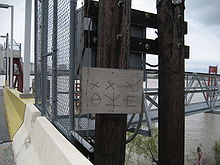
tines of american hobos
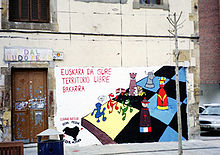
Political mural in the Basque Country: The Basque language is our only free territory
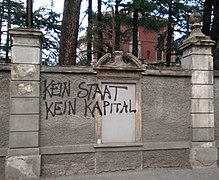
Anti-capitalist graffito in Bolzano
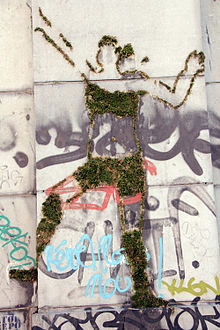
Moss graffito in Brussels

Viral dandelion graffito of the Užupian Embassy to Munich and for dandelions

Stencil graffito in Munich, 2016: The non-conformist children's book character Pippi Longstocking by Astrid Lindgren stands for a breakout from gender roles.

A house in São Paulo with typical Pixação graffiti

18th Street Gang Graffiti in South Central Los Angeles
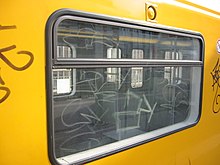
Scratchings at a window of the Berlin subway
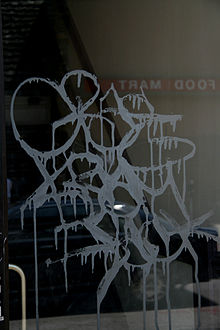
Etching tags in Chicago

Various Style-Writing-Pieces in Berlin
Questions and Answers
Q: What is graffiti?
A: Graffiti refers to marks, scratching, or drawings that are created on a surface in a public place.
Q: How is graffiti usually created?
A: Graffiti is usually created using paint or spray paint that is sprayed from a can.
Q: What is a graffito?
A: A graffito is a single mark of graffiti on a surface.
Q: What are the different forms of graffiti?
A: Graffiti can take the form of art, drawings, or words.
Q: When is graffiti considered vandalism?
A: Graffiti is considered vandalism when it is created without the property owner's consent.
Q: Is graffiti always a political protest?
A: No, graffiti can be something as simple as a person's name or a rude word. However, it can also be a public political protest because it is illegal without permission.
Q: What is the significance of getting a property owner's permission?
A: Getting a property owner's permission is important because creating graffiti without it is considered vandalism and can result in legal consequences.
Search within the encyclopedia